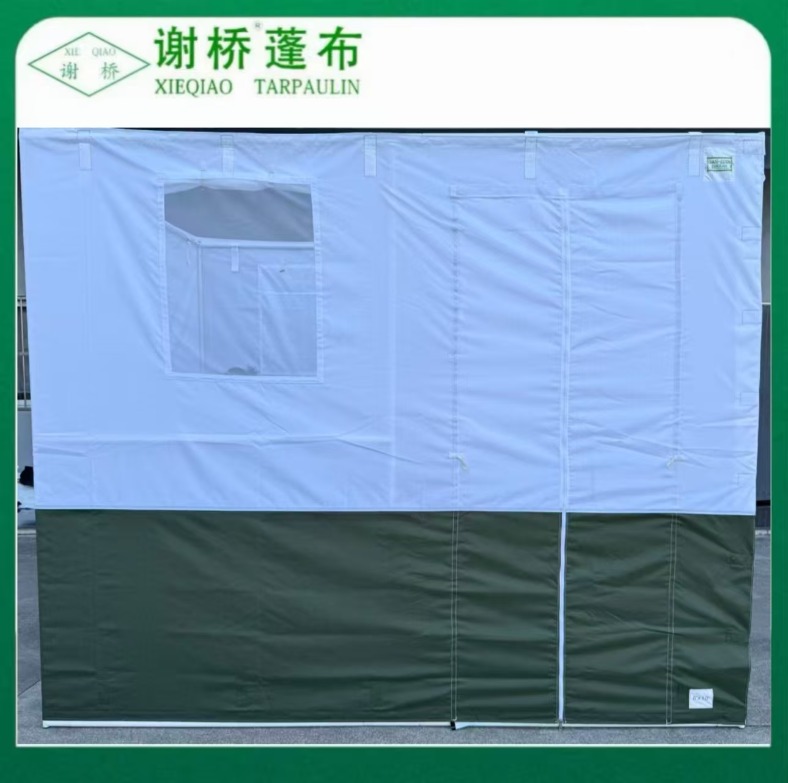Specializing in all kinds of custom tarpaulins Custom Tarpaulin Product Manufacturers
 2025.10.15
2025.10.15
 Industry News
Industry News
For many families and communities, a Sukkah is a central part of the Jewish festival of Sukkot, serving as a temporary dwelling where meals, prayers, and family gatherings take place. Traditionally, Sukkahs were made from simple materials such as wood, canvas, or cloth, requiring assembly and disassembly each year. However, modern innovations have led to the development of zippered walls waterproof Oxford Sukkah tents, which combine convenience, durability, and weather resistance. One of the most common questions among buyers is: how durable are these tents for outdoor use over multiple years?
This article explores the durability of zippered walls waterproof Oxford Sukkah tents, analyzing the materials, design features, maintenance practices, and environmental factors that affect their longevity. By understanding these factors, users can make informed decisions to ensure that their Sukkah tent remains functional, safe, and aesthetically appealing over time.
The primary material used in these Sukkah tents is Oxford fabric, a woven polyester material known for its strength, durability, and resistance to tearing. Oxford fabric is often coated with waterproof layers, providing protection against rain, humidity, and light snow. Key properties include:
The zippered walls are a critical component of the tent’s durability. High-quality tents use metal or heavy-duty nylon zippers that can withstand repeated use without breaking. Reinforced stitching around stress points, corners, and zipper seams also contributes to the tent’s long-term stability.
Durable Sukkah tents rely on strong support poles, often made of aluminum or powder-coated steel. These materials are lightweight yet sturdy, resisting bending, rust, and corrosion over multiple years. The poles are designed to hold the weight of the fabric, withstand moderate wind, and maintain structural integrity during extended outdoor use.

The design of the tent plays a major role in its durability. Key features that improve lifespan include:
The zippered walls not only provide easy access but also protect the interior from harsh weather, insects, and debris. By fully enclosing the Sukkah when needed, the fabric is shielded from excessive wind stress, reducing wear and tear.
High-quality tents incorporate double-stitched seams and reinforced corners, which are typically the first areas to experience stress. These reinforcements prevent fabric fraying and extend the life of the tent, even after repeated assembly and disassembly.
Some tents feature adjustable tension straps or clips that allow users to tighten the fabric around the frame. Proper tension prevents sagging, water pooling, and flapping in the wind, all of which can degrade materials over time.
Even though the tent is waterproof, effective ventilation prevents condensation and mold growth inside. Small mesh vents or removable panels allow airflow, preserving the fabric’s integrity and maintaining a comfortable interior environment.
The durability of a Sukkah tent is influenced not only by materials and design but also by environmental exposure. Key factors include:
Prolonged exposure to direct sunlight can cause fading and weakening of fabric fibers, even in UV-treated materials. To minimize damage, users may:
Although waterproof Oxford fabric prevents water penetration, heavy rain or snow accumulation can stress seams and poles. Regularly clearing the roof and ensuring proper tension can prevent sagging or water damage.
Strong winds can place significant strain on tents, particularly on zippered walls and corner seams. Durable tents often feature wind-resistant frames, tie-down straps, and stakes to stabilize the structure. Proper anchoring is essential for long-term use, especially in areas prone to gusty conditions.
Extreme heat or cold can impact both fabric and structural materials. High temperatures may accelerate fading and resin degradation, while freezing conditions can make fabric brittle. Choosing tents rated for a wide temperature range enhances longevity.
Proper maintenance is critical for ensuring that a zippered walls waterproof Oxford Sukkah tent remains durable over multiple years. Recommended practices include:
With consistent maintenance, a high-quality Sukkah tent can last 5–10 years or more, depending on usage frequency and environmental conditions.
Choosing a durable, waterproof Oxford Sukkah tent with zippered walls offers several benefits for long-term outdoor use:
Users who purchase premium zippered walls waterproof Oxford Sukkah tents report that:
By contrast, lower-quality tents with thin fabric, weak poles, or cheap zippers may degrade after 1–2 years, especially in areas with harsh weather conditions.
A zippered walls waterproof Oxford Sukkah tent can be highly durable for outdoor use over multiple years, provided it is constructed from high-quality Oxford fabric, reinforced seams, durable zippers, and sturdy aluminum or steel poles. The tent’s design features, including zippered walls, reinforced corners, and adjustable tension systems, further enhance longevity by reducing wear and tear caused by wind, rain, and regular usage.
Environmental exposure and maintenance practices play a significant role in determining lifespan. By protecting the tent from extreme conditions, cleaning and drying it properly, and storing it in a controlled environment, homeowners can expect their Sukkah tent to remain functional and visually appealing for 5–10 years or more.
For families and communities seeking a convenient, weather-resistant, and long-lasting Sukkah solution, investing in a durable zippered walls waterproof Oxford Sukkah tent represents both a practical and aesthetically satisfying choice, combining tradition with modern innovation.